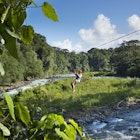

Over ice and iron girders, shinnying up temples and scaling rainforest trees ' tackle the world's most worthwhile ways to reach the top. In this excerpt from Lonely Planet's 1000 Ultimate Experiences we've gathered together ten things to go up, from the somewhat gentle to the downright difficult. Let's just hope you can get down.
1. Tikal, Guatemala

Image by mockney_piers
Ascending the steps of a 1250-year-old temple at the ancient Mayan megacity of Tikal to climb above the Petén jungle is one of Central America's greatest experiences. During the first millennium AD this site was the main metropolis of the Maya, one of the mightiest pre- Columbian civilisations. There are a clutch of ruins to roam, but tallest and most tantalising is Temple IV at the west of the complex. From the top Tikal's three other temples can be seen soaring out of the treetops 'more unexcavated ruins lie hidden in the jungle. Stay virtually on the edge of Tikal's temple flanked central plaza at Jungle Lodge, with one of Petén’s best pools.
2. Sossusvlei, Namibia

Image by gregw66
The world's highest dunes, the world's oldest dunes you won't be here long before the record-breaking sand statistics rear their heads, but Sossusvlei certainly boasts among the most mesmerising dunes on the planet for clambering over. Dunes here reach as high as 325m, but as sand walking is around 2½ times tougher than it would be on a normal surface, climbing is far from simple. The park Sossusvlei sits in, a swath of sand covering a good third of Namibia, fans out in all directions from the dune summits in a kaleidoscope of colours from blood red to amber to mauve. Stick to the dune's crests for the easiest ascents. Dawn is ideal dune-viewing time: stay inside the park boundaries for those early starts.
3. Perito Moreno Glacier, Argentina

Image by longhorndave
Hearteningly in these times of global warming, this glacier is among the few on the planet not actually retreating. Forming a 3km, 60m-high icy frontier against the lake it abuts, Perito Moreno advances only for lake water to periodically undermine and, in spectacular style, collapse it. Five-hour glacier treks bring you up close and personal to the glacier's myriad peaks, fissures and, if you're lucky, the ice cavern the lake hollows underneath, all effusing an ethereal blue glow. If the trek isn't a sufficient vertical challenge, try the ice climb, 20m up a sheer ice wall, and the ice abseil back down. El Calafate is littered with agencies offering glacier tours.
4. Old Man of Hoy, Orkney Islands, Scotland

Image by Effervescing Elephant
Gather your grappling hooks, fasten your crampons – you’ll need technical gear to scale this iconic sea stack, standing just offshore from some of Britain's highest cliffs on the wild island of Hoy. Flat, fertile Orkney isn't renowned for rock climbing but the Old Man is a big exception. The 450ft rock tower thwarted attempts to climb it until 1966, way after Everest had been conquered. Scale soon to avoid disappointment: one of the Old Man's 'legs' was washed away in 19th-century storms; geologists reckon the rest of the stack will ultimately follow suit. Get detailed information on climbing Orkney sea stacks at www.ukclimbing.com. Guided ascents of the Old Man are possible.
5. Volcanoes National Park, Big Island, Hawaii

Image by elisfanclub
Five volcanoes rise in a veritable smorgasbord of ruptured, frequently fiery peaks out of the lunar-like massif which makes up this World Heritage–listed national park: lava junkies should head here for a phenomenal fix. Not only are the world's most dramatic volcanic vistas located on Big Island (try the most active, highest and largest volcanoes) but the craters are easily accessible (a road runs round the rim of Kilauea). Roads shouldn't dishearten climbers from hitting the trails – some 240km of paths take the intrepid out to less-visited parts of the park. Check out offerings to Pele, Hawaiian Goddess of Fire, en route: gifts from seashells to gin are left to appease her fiery wrath. Plan climbs and keep tabs on lava sightings in the park at www.nps.gov/havo.
6. Crac des Chevaliers, Syria

Image by peuplier
It's not particularly tough climbing this 12th-century Crusader castle but the challenge of ascent isn't everything, especially once you're greeted with the view from the parapets. Dubbed the 'most wholly admirable castle in the world' by TE Lawrence, the fortress stands atop a 650m outcrop on a historically important through-route to the Mediterranean coast. Crac was defensively sound enough for the Knights Hospitaller to make the castle their Crusade headquarters in 1142, and is famous for its walls never having been breached (despite multiple attempts by the Saracens). Reaching the battlements is easier for visitors today but the surrounding lush, ancient-monument peppered Orontes Valley has changed little over the centuries. Scale early to avoid tour busloads. Hama is the prettiest base for visiting Crac.
7. Canopy Walkway, near Iquitos, Peru

Image by anoldent
For a long time this 500m walkway, strung between trees in the Peruvian jungle, was difficult to visit, with access largely restricted to researchers. It's easy to see why they flocked – this is one of the best ways to appreciate jungle birdlife on the planet. Now the intrepid traveller, too, can scramble up above the rainforest canopy to be put into prime viewing position for a visual feast of tropical avian activity. Public walkway access is exclusive to guests of Explorama. Their ExplorNapo Lodge is a half hour walk away.
8. Stok Kangri, India

Image by kun0me
One of the world's only non-technical climbs in excess of 6000m, the peak of Stok Kangri often yields better views of the Great Himalayas than the Great Himalayas themselves. Allowing for acclimatisation, it's a four- or five-day trek to the summit. This is about as high as non-professional mountaineers get on the planet: a clear day sees exquisite views of K2, with the huge Ladakhi capital of Leh a mere speck on a horizon, hemmed in by the imposing mountains of the Karakoram Range. Pamper yourself after your mountain exertions with a stay at the luxurious Grand Dragon Ladakh.
9. Sydney Harbour Bridge, Australia

Image by SpecialKRB
Ever seen Roger Moore's Bond in A View to a Kill and fancied climbing one of the world's largest bridges, girders and all? Your best bet lies in Sydney, not San Francisco, where scaling the Sydney Harbour Bridge takes you to a dizzying 134m above the photogenic harbour. Three types of climbs are offered on the planet's biggest steel arch bridge; wedding ceremonies have even been conducted on top. Vertigo-sufferers can content themselves with ascending the Pylon Lookout at the southeast end of the bridge: a modest 87m, climbed via steps rather than hair-raising catwalks. Bridge-climbing is a popular activity in Sydney these days: visit www.bridgeclimb.com for details. The Pylon Lookout is open from 10am to 5pm daily.
10. Mt Kilimanjaro, Tanzania

Image by paulshaffner
Not featuring Africa's highest mountain in a compendium of great climbs, with its bird's-eye views of the wildlife studded savannah way below, would be a travesty. At 5895m this clocks in as the highest freestanding mountain in the world, with a stunning variety of routes to the summit. One way up sees you accompanied part-way by a ranger to protect you against Big Game; others take you past Kilimanjaro's glaciers and have you camping overnight in a volcanic crater. Climb above the Serengeti savannah without donning hiking boots on a safari by balloon.
Explore related stories







 Wildlife & NatureThe 11 best things to do in Scotland from spotting puffins to bagging peaks
Wildlife & NatureThe 11 best things to do in Scotland from spotting puffins to bagging peaksOct 15, 2024 • 8 min read
 CyclingFrom the Highlands to the islands, here’s how to get around Scotland
CyclingFrom the Highlands to the islands, here’s how to get around ScotlandOct 15, 2024 • 9 min read

